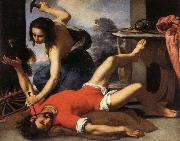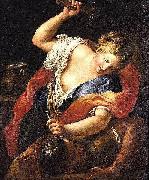Wholesale Oil Painting Reproductions No Minimum and Door to Door! |
|||||||||||
|
|
|||||||||||

|
|||||||||||
|
|
|
||||||||
All Felice Ficherelli Oil Paintings |
||||||||
|
|
||||||||
|
|
||||||||
|
Artist Introduction: Italian painter , b. 1603, San Gimignano, d. 1660, Firenze
Firenze,Italian painter. His most original works were easel pictures, for private collectors, often of cruel and violent subjects, which he interpreted with a morbid sensuality and ambiguous tenderness. He was brought to Florence when very young by the collector Conte Alberto Bardi (d 1632), who arranged for him to study with Jacopo da Empoli and to copy works by Andrea del Sarto. Ficherelli's clear compositions and luminous drapery, which remain evident throughout his career, reflect this training. In the early 1630s he was attracted by the delicate sfumato effects of Francesco Furini and developed a style close to that of Cecco Bravo; his works of this period include the Sacrifice of Isaac (Florence, priv. col., for illustration see Gregori, 1968, p. 26) and the Martyrdom of St Agatha (priv. col., see Cantelli, fig. 338). There followed in the late 1630s Tarquin and Lucretia, which is known in several versions (e.g. Rome, Accad. N. S Luca), the theatrical Julia Receiving the Bloodstained Garments of Pompey (Genoa, priv. col., see 1986 exh. cat., pl. 1.208), an Allegory of Patience (Florence, Bigongiari priv. col., see Gregori, 1974, fig. 23) and Antiochus and Stratonica (Auckland, C.A.G.). |
||||||||
|
|
||||||||
|
Jael and Sisera Painting ID:: 29966 |
mk67
Oil on canvas
47 5/8x61in
|
|||||||
Height Width |
INS/CM Quality |
|||||||
|
X |
| |||||||
|
|
||||||||
All Gregorio Lazzarini Oil Paintings |
||||||||
|
|
||||||||
|
|
||||||||
|
Artist Introduction: (1657 - 10 November 1730) was an Italian painter, mostly of religious subjects, and those from history and mythology.
Born in Venice, he initially trained with the Genovese painter Francesco Rosa, Girolamo Forabosco, and with the studio of Pietro della Vecchia. He joined the painters' guild in Venice in 1687. |
||||||||
|
|
||||||||
|
|
Jael and Sisera Painting ID:: 83221 |
Date second half of 17th century
Medium Oil on canvas
Dimensions Height: 117 cm (46.1 in). Width: 95 cm (37.4 in).
cjr |
||||||
Height Width |
INS/CM Quality |
|||||||
|
X |
| |||||||
|
|
||||||||
All Gregorio Lazzarini Oil Paintings |
||||||||
|
|
||||||||
|
|
||||||||
|
Artist Introduction: (1657 - 10 November 1730) was an Italian painter, mostly of religious subjects, and those from history and mythology.
Born in Venice, he initially trained with the Genovese painter Francesco Rosa, Girolamo Forabosco, and with the studio of Pietro della Vecchia. He joined the painters' guild in Venice in 1687. |
||||||||
|
|
||||||||
|
|
Jael and Sisera Painting ID:: 87310 |
second half of 17th century
Medium Oil on canvas
cyf |
||||||
Height Width |
INS/CM Quality |
|||||||
|
X |
| |||||||
|
|
||||||||
|
Prev Next
|
||||||||
|
|
||||||||
|
Related Paintings to Gregorio Lazzarini :. |
||||||||
|
|
||||||||
|
CONTACT US |



